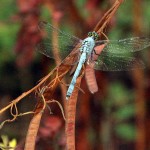These little busybodies are hard to pin down. They flitter from branch to branch so quickly that it is difficult to get the camera on them in time for a clear shot—especially at close range.
This Carolina Chickadee was close enough—maybe even a little too close, as the camera angle is from a little further below the bird than what I would have preferred. Still, when it comes to these flighty little birds I will take what I can get!

Here is how Wikipedia describes the Carolina Chickadee:
The Carolina Chickadee (Poecile carolinensis) is a small passerine bird in the tit family Paridae. It is often placed in the genus Parus with most other tits, but mtDNA cytochrome b sequence data and morphology suggest that separating Poecile more adequately expresses these birds’ relationships (Gill et al., 2005). The American Ornithologists’ Union has been treating Poecile as distinct genus for some time already.
Adults are 11.5–13 cm (4.5–5.1 in) long with a weight of 9–12 g (0.32–0.42 oz), and have a black cap and bib with white sides to the face. Their underparts are white with rusty brown on the flanks; their back is grey. They have a short dark bill, short wings and a moderately long tail. Very similar to the Black-capped Chickadee, the Carolina Chickadee is distinguished by the slightly browner wing with the greater coverts brown (not whitish fringed) and the white fringing on the secondary feathers slightly less conspicuous; the tail is also slightly shorter and more square-ended.






